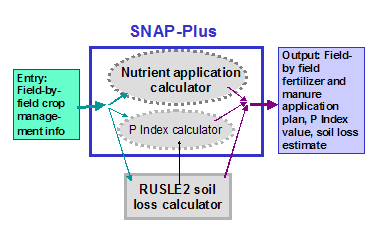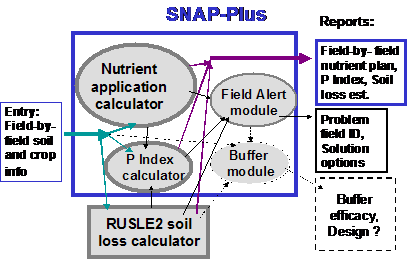SNAP-Plus Research Team
The SNAP-Plus research team is working to expand and adapt the SNAP-Plus software program as a delivery mechanism for the Wisconsin Buffer Initiative research findings and policy. They will expand original SNAP-Plus capabilities to allow users to assess the effectiveness of in-field and edge-of-field buffers on sediment and phosphorus delivery to nearby water bodies. An expanded SNAP-Plus will allow field-by-field assessment of buffer efficacy at the farm level and will provide the WBI with a practical buffer planning tool for farmers and agricultural consultants.
What is SNAP-Plus?
SNAP-Plus is a nutrient management planning software program that was originally capable of producing:
- Field-by-field fertilizer and manure application plans consistent with Nutrient Management Standard 590
- Rotational soil loss estimate (RUSLE2)
- Rotational and annual phosphorus delivery to nearby surface water with the P Index
SNAP-Plus originally allowed users to assess the effects on sediment and phosphorus losses of changes in:
- Crop choice
- Tillage
- Manure application strategy
Original design of the SNAP-Plus Software Program:

The team is working to expand the SNAP-Plus program to include a "Problem Field Alert" module and a "Buffer Assessment" module" (Figure 2). The Problem Field Alert module will use the output generated by the nutrient management planner, the P Index, RUSLE2, and WBI-generated receiving water sensitivity information and provide a list of fields where P and soil losses will have an unacceptable water-quality impact. It will also provide a list of potential management solutions and a link to the Buffer Assessment module when appropriate. The content of the Buffer Assessment module will depend on the outcome of the WBI PALMS modeling effort. The P Index and RUSLE2 are comparatively simple and much less data-intensive predictors of field-level P and sediment losses than the PALMS model. If the results from PALMS modeling indicate that it is possible to use these simpler models to calculate buffer width and extent requirements under some field situations, the Buffer Assessment module will be designed to do this. At the very least, the Buffer Assessment module will be a practical screening tool to determine where edge-of-field buffers are suitable.
Proposed expanded SNAP-Plus with edge-of-field buffer assessment functions:


